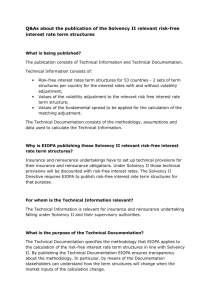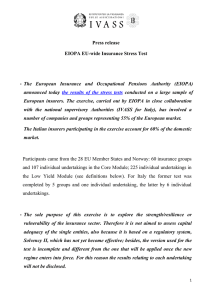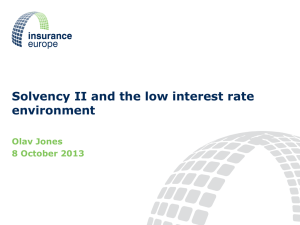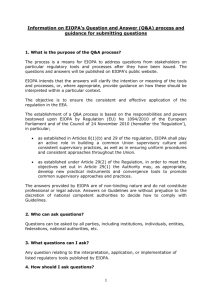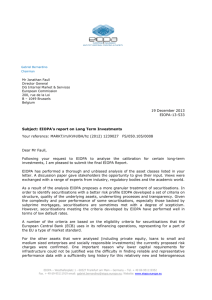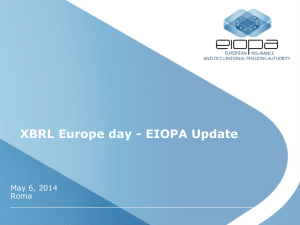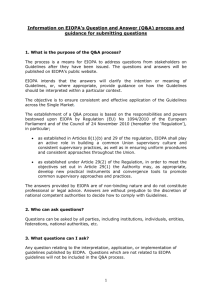Key messages on the EIOPA report on Long
advertisement
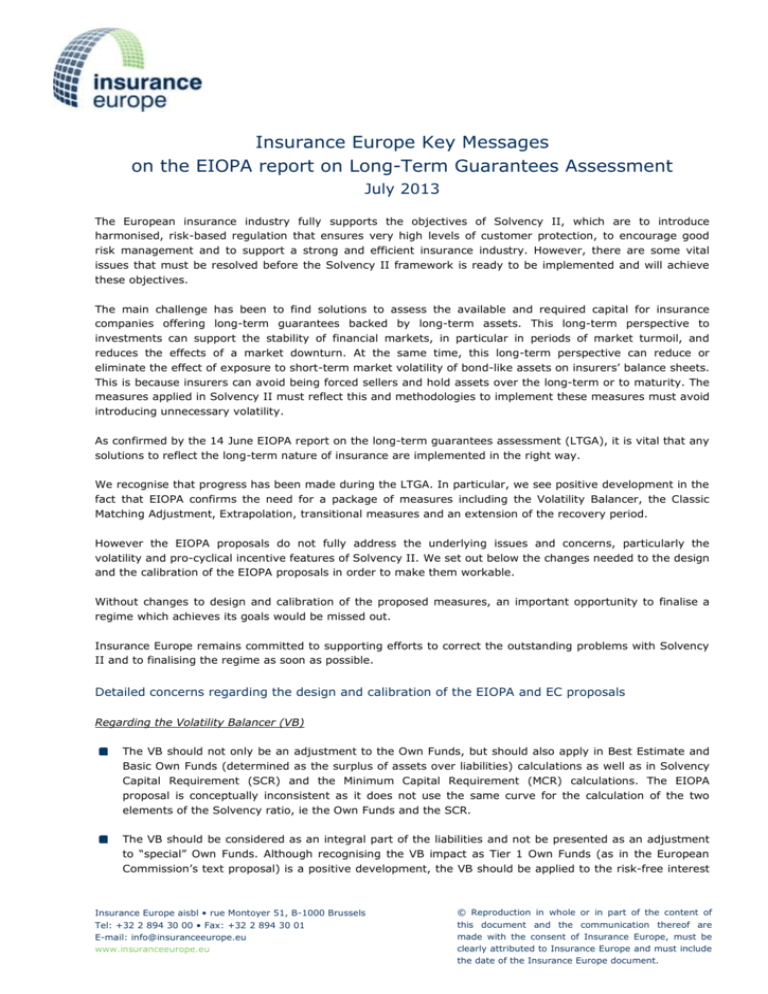
Insurance Europe Key Messages on the EIOPA report on Long-Term Guarantees Assessment July 2013 The European insurance industry fully supports the objectives of Solvency II, which are to introduce harmonised, risk-based regulation that ensures very high levels of customer protection, to encourage good risk management and to support a strong and efficient insurance industry. However, there are some vital issues that must be resolved before the Solvency II framework is ready to be implemented and will achieve these objectives. The main challenge has been to find solutions to assess the available and required capital for insurance companies offering long-term guarantees backed by long-term assets. This long-term perspective to investments can support the stability of financial markets, in particular in periods of market turmoil, and reduces the effects of a market downturn. At the same time, this long-term perspective can reduce or eliminate the effect of exposure to short-term market volatility of bond-like assets on insurers’ balance sheets. This is because insurers can avoid being forced sellers and hold assets over the long-term or to maturity. The measures applied in Solvency II must reflect this and methodologies to implement these measures must avoid introducing unnecessary volatility. As confirmed by the 14 June EIOPA report on the long-term guarantees assessment (LTGA), it is vital that any solutions to reflect the long-term nature of insurance are implemented in the right way. We recognise that progress has been made during the LTGA. In particular, we see positive development in the fact that EIOPA confirms the need for a package of measures including the Volatility Balancer, the Classic Matching Adjustment, Extrapolation, transitional measures and an extension of the recovery period. However the EIOPA proposals do not fully address the underlying issues and concerns, particularly the volatility and pro-cyclical incentive features of Solvency II. We set out below the changes needed to the design and the calibration of the EIOPA proposals in order to make them workable. Without changes to design and calibration of the proposed measures, an important opportunity to finalise a regime which achieves its goals would be missed out. Insurance Europe remains committed to supporting efforts to correct the outstanding problems with Solvency II and to finalising the regime as soon as possible. Detailed concerns regarding the design and calibration of the EIOPA and EC proposals Regarding the Volatility Balancer (VB) The VB should not only be an adjustment to the Own Funds, but should also apply in Best Estimate and Basic Own Funds (determined as the surplus of assets over liabilities) calculations as well as in Solvency Capital Requirement (SCR) and the Minimum Capital Requirement (MCR) calculations. The EIOPA proposal is conceptually inconsistent as it does not use the same curve for the calculation of the two elements of the Solvency ratio, ie the Own Funds and the SCR. The VB should be considered as an integral part of the liabilities and not be presented as an adjustment to “special” Own Funds. Although recognising the VB impact as Tier 1 Own Funds (as in the European Commission’s text proposal) is a positive development, the VB should be applied to the risk-free interest Insurance Europe aisbl • rue Montoyer 51, B-1000 Brussels Tel: +32 2 894 30 00 • Fax: +32 2 894 30 01 E-mail: info@insuranceeurope.eu www.insuranceeurope.eu © Reproduction in whole or in part of the content of this document and the communication thereof are made with the consent of Insurance Europe, must be clearly attributed to Insurance Europe and must include the date of the Insurance Europe document. rate curve used to calculate the Best Estimate liabilities - this is in line with the approaches used for other LTG measures and there is no reason to treat the VB any differently. Additionally, the public disclosure as a specific Own Funds item risks making the VB seem temporary and artificial, and consequently risks negating any positive effect on financial stability. Reporting the impact to the supervisor should be sufficient. The VB calibration severely limits the effectiveness of this measure by introducing an excessively high and arbitrary 80% haircut on the spread of a reference portfolio. Without appropriate calibration, the VB will not work as intended as the remaining volatility will still be unmanageable, especially during crisis periods. Additionally, EIOPA’s results stating that the VB as currently designed and calibrated (around 25bps at year-end 2011) would have the same effect as a 100bps CCP with a capital charge on CCP seem too optimistic. The industry is currently carrying out additional technical analysis in this area and notes that the EIOPA report states that “Further analysis needs to go into final calibrations of the approach”. A number of national supervisors already mentioned they could not match the EIOPA figures for their own market. Adjustments for volatility created where national government bond spreads differ significantly from the European average is a vital part of the system. However it is currently limited to remote situations and therefore risks creating cliff effects and significant volatility for companies investing in their national government bonds. In our view, an explicit integration of a national component in the formula, combined with no or lower trigger levels, should be investigated. There is also a need for clarification on the application of this component for groups operating in several European countries. Additionally, the proposed national add-on component only applies to adverse market situations going along with extremely high spreads. It should be explored how other market distortions, like a persistent low interest rate environment, can be covered as well. The predictability of the VB is a significant improvement compared to the previous CCP mechanism in order to ensure the effectiveness of the mechanism (as stated in the EIOPA report). However, not allowing companies to anticipate changes to the VB (as suggested by the European Commission’s text proposal) would offset the benefit of such a predictable and formula-based adjustment. The removal of any entity specific adjustment (which featured in the extended matching adjustment) could be an acceptable compromise to finalise Solvency II. However, it should be recognised that entityspecific calibrations capture well the asset-liability features of individual companies and therefore mitigate short-term volatility impacting a company’s balance sheet more efficiently. Regarding the Classic Matching Adjustment (CMA) We welcome a number of positive developments recognising the economic justification and effectiveness to better reflect the risks. The concept is based on the fact that, where insurers can avoid being forced sellers and hold assets over the long-term or to maturity, their balance sheets are exposed to default risk rather than the market (spread) risk. However, the current proposal still includes strict criteria which are not justified from an economic and risk management point of view and which make the measure less effective in some countries and even ineffective in most countries: Restrictions on the scope for assets, allowing only assets with fixed cash flows and therefore unnecessarily excluding a significant part of some insurers’ investment portfolio Restrictions on investments in BBB-rated assets to 33% of total investments and the exclusion of any assets rated below BBB Ring-fencing requirements which are still unworkable and therefore should be replaced by provisions making sure that eligible assets and liabilities are separately identified with a register-type approach. 2 Registers of the type envisaged have proved workable and effective as part of the regulatory framework in a number of member states. The inclusion of artificial floors in the CMA calibration without any economic justification: 75% of the long-term average spread for corporate bonds and 30-40% of current spread for government bonds (or 35% of the long-term average spread as in the European Commission’s text proposal) Strict asset-liability matching requirements and the lack of the possibility to split contracts, which make this measure unworkable in countries where long-duration bonds to match the whole term of the liabilities are insufficient More consideration should also be given to the determination of fundamental spreads, in particular for government bonds and for assets with insufficient historical data to calculate long-term average spreads. Moreover, although we understand this to be a drafting mistake, the European Commission’s text proposal currently limits the matching adjustment for BBB rated bonds to the level of AAA rated bonds, instead of the previous limit at the level of A rated bonds (as tested in the LTGA). Lastly, the requirement for public disclosure of the impact of this measure risks leading to misinterpretations, thereby negating any positive effect on financial stability. Reporting the impact to the supervisor should be sufficient. Regarding extrapolation The extrapolation should start at year 20 (for the Euro) and have a convergence period of 10 years. EIOPA’s recommended change to a 40 year convergence (for the Euro) is contrary to the consensus reached in the Parliament and in the Council and will increase volatility and therefore make the valuation of technical provisions less predictable. Additionally, the results of the impact assessment do not support the proposed increase in the convergence period. The main reason is that extrapolation methods were not tested as stand-alone measures (ie without any other measures) by analysing the impact of different parameters, such as the last liquid point (LLP) or the speed of convergence towards the ultimate forward rate (UFR). For instance, the extrapolation scenarios also applied a 100 bps CCP, resulting in an upward shift of the risk-free interest rate curve before extrapolation. The introduction of a short convergence period of 10 years towards the UFR is essential to allow undertakings to establish a consistent and robust long-term asset-liability strategy, to cope adequately with long-term uncertainties and to properly avoid volatility. A faster speed of convergence is also likely to benefit policyholders since it enables a longer-term view of the investment horizon and asset management. Moreover, this short convergence period should not be interpreted as a measure which decreases prudence in the valuation of the technical provisions – as it works both ways depending on the level of interest rates. On the contrary, the UFR should be seen as a stable anchor point reflecting longterm expectations on interest rates and inflation and therefore allowing for adequate predictability while limiting excessive volatility. Regarding transitional measures While we acknowledge that EIOPA has started tackling some of the aspects and also expressed the potential need for several transitionals, it is important that transitionals have sufficient duration in order to be effective. It is also important that these measures are applicable to different types of existing business, taking into account local market specifics whilst avoid accentuating existing market differences and arbitrary decisions by local regulators. The application of transitional measures should in any case be optional for companies. 3 Moreover, transitionals should be applicable in Best Estimate calculations, rather than being an adjustment to Own Funds (as for the other LTG measures). The EIOPA proposal is conceptually inconsistent as it does not use the same curve for the calculation of the two elements of the Solvency ratio, ie the Own Funds and the SCR. In our view, at least one of the transitionals should be ‘dynamic’, taking account of changing financial market conditions. It is important that the designs of the transitional measures are consistent with the Solvency II methodology. The aforementioned inconsistency needs to be resolved. A consistent transitional interest rate curve needs to be implemented to allow for a sustainable and sensible transition from Solvency I to Solvency II. The tested 7 year transitional is inappropriate and should be extended. The duration of the transitional measures should reflect the duration of insurance obligations, to allow for a sensible and sustainable solution for existing liabilities (ie business written under Solvency I). A substantial extension of the proposed duration is vital. Regarding the extension of the recovery period (ERP) The ERP is a welcomed counter-cyclical measure and we appreciate the extension of the maximum recovery period. However the implementation details are important to assess its potential impact. From the current text it is not clear whether this measure applies only after all other LTG measures have been exhausted, or whether it can be triggered immediately in case of sudden breach of the SCR on a non-adjusted basis (ie without considering other LTG measures). The conditions of application and recovery attached to this measure are important aspects to consider in making sure the ERP leads to the intended outcomes. In order to be effective, we believe that the measure should apply on top of the other measures and that the scope of application should be sufficiently wide and flexible (ie no predefined list of situations that could qualify for an application of the ERP) to cope with all suitable situations. Regarding the credit risk adjustment (CRA) to the swap curve Although not explicitly part of the LTG debate, the CRA is an important calibration element which risks leading to additional and unnecessary volatility and therefore needs to be given more consideration in our view. The CRA, fixed at 35pbs at year-end 2011 in the LTGA, is arbitrary and will create an artificial gap between assets and liabilities. Assets and liabilities should be looked at in combination, meaning that the reference curve used to discount liabilities should be the same curve as the one implied by market prices on the asset side in order to have a consistent asset-liability approach. Additionally, the currently envisaged methodology will cause additional unhedgeable volatility in Own Funds. Therefore the risk-free interest rate curve should be the swap curve versus Euribor 6 months without any adjustment. Bonds are issued on this basis in primary markets (midswap Euribor 6 months + credit spread) and are quoted in secondary markets on the same basis. A 35pbs CRA at year-end 2011 would completely offset the benefit of the VB as currently designed and calibrated. *** 4
